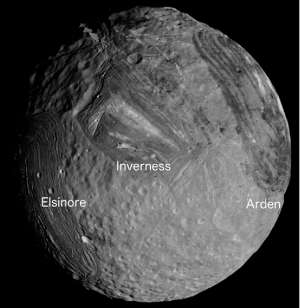Miranda: An Icy Moon Deformed by Tidal Heating

Mosaic of southern hemisphere of Miranda, the innermost regular satellite of Uranus, with radius of 236 km. Projection is orthographic, centered on the south pole. Visible from left to right are Elsinore, Inverness, and Arden coronae. Image credit: NASA/Jet Propulsion Laboratory/Ted Stryk. See related article by Hammond and Barr.
Despite its relatively small size, Miranda appears to have experienced an episode of intense resurfacing that resulted in the formation of at least three remarkable and unique surface features — polygonal-shaped regions called coronae.
These coronae are visible in Miranda’s southern hemisphere, and each one is at least 200 km across. Arden corona, the largest, has ridges and troughs with up to 2 km of relief. Elsinore corona has an outer belt that is approx. 80 km wide, relatively smooth, and elevated above the surrounding terrain by approx. 100 m. Inverness corona has a trapezoidal shape with a large, bright chevron at its center. The northern hemisphere of Miranda was never imaged by the Voyager 2 spacecraft, so it is unknown whether additional coronae exist.
Using numerical models, Noah Hammond and Amy Barr show that convection in Miranda's ice mantle likely formed the coronae. During convection, warm buoyant ice rose toward the surface, driving concentric surface extension beneath the locations of the coronae, causing the formation of extensional tectonic faults. This style of resurfacing is similar to plate tectonics on Earth, in that convection is a primary driving force for surface deformation.
Hammond and Barr write that the internal energy that powered convection probably came from tidal heating. Tidal heating would have occurred when Miranda was in an eccentric orbit — moving closer to and further from Uranus. This caused the tidal forces from Uranus to vary, periodically stretching and squeezing Miranda and generating heat in its ice shell. Hammond and Barr find that convection powered by tidal heating explains the locations of the coronae, the deformation patterns within the coronae, and the estimated heat flow during corona formation.
FEATURED ARTICLE
Global resurfacing of Uranus’s moon Miranda by convection
Noah P. Hammond and Amy C. Barr, Dept. of Geological Sciences, Brown University, 324 Brook Street, Providence, Rhode Island 02912, USA. Published online ahead of print on 15 Sept. 2014; http://dx.doi.org/10.1130/G36124.1.
Other recently posted GEOLOGY articles (see below) cover such topics as
1. The 2004-2008 Mount St. Helens eruptions;
2. The largest landslides on Earth; and
3. The East African Rift Valley.
GEOLOGY articles published online ahead of print can be accessed online at http://geology.gsapubs.org/content/early/recent. All abstracts are open-access at http://geology.gsapubs.org/; representatives of the media may obtain complimentary articles by contacting Kea Giles.
Contact:
Kea Giles
Managing Editor,
GSA Communications
+1-303-357-1057
kgiles@geosociety.org
Media Contact
More Information:
http://www.geosociety.org/news/pr/2014/14-62.htmAll latest news from the category: Earth Sciences
Earth Sciences (also referred to as Geosciences), which deals with basic issues surrounding our planet, plays a vital role in the area of energy and raw materials supply.
Earth Sciences comprises subjects such as geology, geography, geological informatics, paleontology, mineralogy, petrography, crystallography, geophysics, geodesy, glaciology, cartography, photogrammetry, meteorology and seismology, early-warning systems, earthquake research and polar research.
Newest articles

Trotting robots reveal emergence of animal gait transitions
A four-legged robot trained with machine learning by EPFL researchers has learned to avoid falls by spontaneously switching between walking, trotting, and pronking – a milestone for roboticists as well…

Innovation promises to prevent power pole-top fires
Engineers in Australia have found a new way to make power-pole insulators resistant to fire and electrical sparking, promising to prevent dangerous pole-top fires and reduce blackouts. Pole-top fires pose…

Possible alternative to antibiotics produced by bacteria
Antibacterial substance from staphylococci discovered with new mechanism of action against natural competitors. Many bacteria produce substances to gain an advantage over competitors in their highly competitive natural environment. Researchers…





















